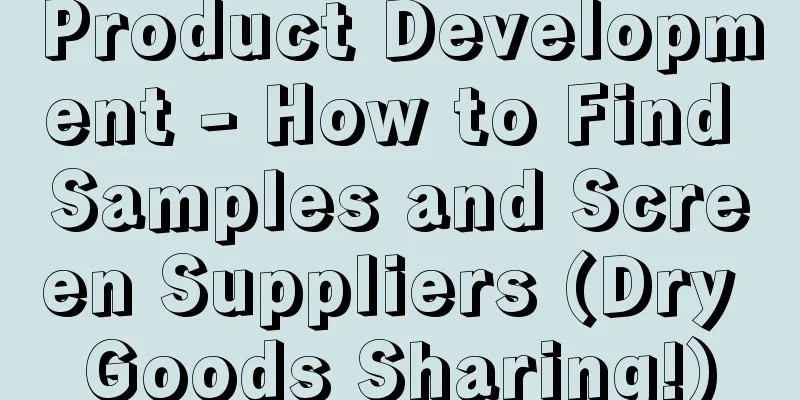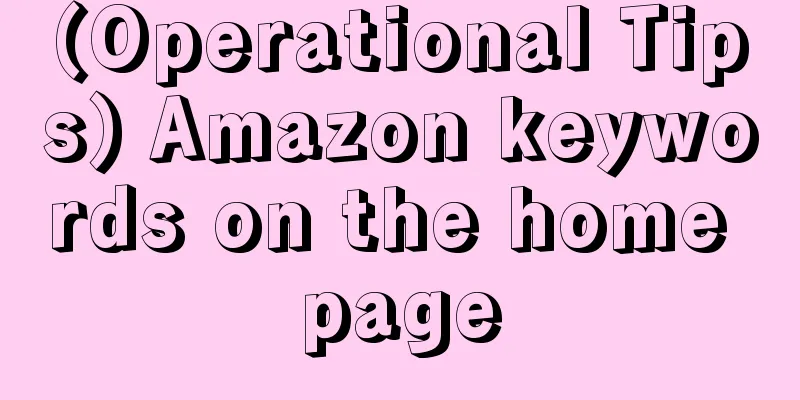Product Development - How to Find Samples and Screen Suppliers (Dry Goods Sharing!)

|
After you have defined your product, you should have a rough idea of what kind of product you want. Then, based on your product definition, you can start looking for samples. There are many ways to find samples, but here we will only talk about the two most commonly used ones: 1. Ask through suppliers you are familiar with. After all, they are the experts in this category and their resources are definitely richer than yours, so it is most efficient to find them. Another advantage of finding familiar suppliers is that these suppliers are those you have already screened and will be relatively reliable, so the communication cost will be lower. Good suppliers will also give you some product suggestions to help you improve your products. 2. Search through 1688: Assuming that the product you are looking for is a category you have never dealt with before and you do not have any supply chain accumulation in this area, then you will use the most common method, which is also the most commonly used method by ordinary people: find Jack Ma (1688). Search product keywords on 1688, or find the product image you are referring to and search for it on 1688. When you see a product that you think is similar, just click the "similar" or "same style" button, which can help you save a lot of time. The process of finding samples is usually not smooth sailing, because there may be two results when you use the above method to find samples: they are in stock or they are not in stock. If there is stock, then you will be more relaxed. The next step is to select suppliers, buy samples, and do sample analysis. After confirming the supplier, you can buy a small amount of stock and send it to test the model first. (How to select suppliers and what to confirm will be discussed later.) But in most cases, there is no stock, so you can either choose similar samples, buy them back for sample analysis, and then decide which one is suitable, and then weigh the pros and cons to find a balance. Or you can customize it, ODM or OEM. (It is not recommended to do O orders right away, unless it is a category you are familiar with. Otherwise, if you do O orders right away for a new category, if the product is not popular, the cost will be very high.) No matter what method you use to find samples, and no matter whether they are in stock or not, there is one thing in common, that is, you need to buy samples, analyze them yourself , analyze the pros and cons of the samples, use them yourself or let uninformed colleagues use them, and give you real feedback on the usage experience. Only in this way can you personally understand the usage scenarios and usage requirements of this product. This is something I must do when doing development. How to screen suppliers Advice for finding suppliers : You must find the manufacturer directly, because this will save you a lot of communication costs. I believe that some people can resonate with this. I once took a detour when I was doing development. I chose a product and found a supplier on 1688. The delivery period, payment period, minimum order quantity, after-sales service, price, etc. were all negotiated. After the product arrived, it was given to the sales to sell. As a result, there were some problems with the product itself. We didn’t notice it ourselves, but after the buyer gave feedback, we found out that we immediately contacted the supplier to change this place. As a result, the other party said that there was no problem, but kept delaying. The communication was not smooth. Later, I found out that he was just an agent and they couldn’t solve these problems. As a result, our plan was disrupted and we were forced to give up this product directly. As for some other accidents, I won’t list them one by one. It’s all tears to talk about them. There are several advantages to going directly to the manufacturer : 1. The after-sales service of the products is relatively guaranteed. In fact, some things are just minor problems and the manufacturer can just take them back and deal with them, but it will be very troublesome for the agent to deal with them. 2. For later modifications and upgrades of the product, if it is the manufacturer, they can give you more support, the communication cost will be much lower, and the communication efficiency will be greatly improved. 3. The factory allows you to inspect the factory, and you can learn about the factory’s situation: production capacity, price, equipment status, industry information, shipment volume, delivery time, payment period, product knowledge, etc. 4. When buying samples, you should buy samples from the manufacturer. There is no point in buying samples from the agent. You buy samples from the manufacturer and finally decide to find this factory to make the products. You can also have a rough judgment on the quality of the products made by this factory. Next, let’s talk about tips : 1. How can I quickly determine that the other party is a factory during an inquiry? I personally don’t like to talk too much during the inquiry process, so my method is relatively simple and crude. I first make a simple inquiry on 1688, and then directly ask: "Hello, I am from Shenzhen **** Company, mainly engaged in Amazon. I am quite interested in your products and would like to see if there is a chance to cooperate with your company. Are you a factory?" If the other party is a factory, the answer will generally be more affirmative: "Yes, we are a factory, the factory is located in ****, welcome to the factory to discuss cooperation" If the other party answers: "Yes, it is a factory," you can reply with "That's great, can I go to your factory to have a look? / Can I inspect the factory?" If the other party's reply is vague, then you can just pass it and there is no need to waste too much time on it. Because logically speaking, if I were a factory, I would very much welcome customers to come to negotiate. After all, the transaction rate of customers who come to the factory will be much higher. Who would refuse business? 2. How to screen suppliers? After you have confirmed that you bought the samples from the factory and analyzed them yourself, you can identify several suppliers. Then you can screen from among these suppliers. If you are looking for a factory, try to find a factory near your city. Taking Shenzhen as an example, when we look for suppliers, we generally try to find factories in the Pearl River Delta region, so that it is convenient to go to the factory in person to inspect the factory and discuss cooperation. If there are any subsequent problems or if there are product improvements and upgrades that need to be communicated, you can go directly to the factory to talk, and the communication efficiency will be higher. (Of course, I said try your best. For example, if you are making knitted products, then the supply chain advantage is definitely in the Jiangsu and Zhejiang areas. This also depends on the supply chain of the product. Some people will also find other regions for exclusive supply chains. For example, there was a company that made aromatherapy lamps before, and their supplier was in New Delhi, India. I am just saying here that under normal circumstances, if the surrounding areas can meet the needs, it is better to stay in the surrounding areas. The above approach is just a general approach.) After screening out a group of suppliers through the above methods, you can make a list of suppliers, first record the address, phone number, main business, contact person, and sample information of these suppliers, and then leave a note column at the end. This note column is to be improved after visiting the factory. The next step is to run according to the list of suppliers in turn. So should you go directly? NO! If you go directly to the factory to talk, you may be slaughtered like a pig, and it is difficult to have an advantage in price. So you must do your homework before going. Take buying a used car as an example. If you know cars and know the industry, you can basically keep the price very low and it is not easy to be cheated. But if you don’t know, then you may spend a high price and buy an accident car. So to do homework, you must first understand this industry and learn about industry information from multiple channels. You can learn from familiar suppliers, ask old developers, or go directly to 1688 and use another small account to inquire. Ask everything you want to ask. If one ignores you, you can ask two. They will give you a lot of useful information. Anyway, the other party will not jump over from the other side of the screen to hit you, so there is no need to have any psychological burden. Do your homework and understand the situation clearly before going to the factory to negotiate. This way you can get twice the result with half the effort and you won’t be easily cheated. 3. How to negotiate with suppliers and what to discuss? There are some tips on how to talk and what to talk about. First of all, there are a few points that must be confirmed (take out a small notebook and write them down, and start to highlight the key points): Product quality, delivery time, factory production capacity, shipment volume, after-sales service, price, payment period, who will bear the freight, whether it comes with packaging and instructions, product-related certifications, whether there will be infringement risks, etc., these must be confirmed. Things you can talk about: asking about industry information, product materials, supply chain distribution, factory history, the boss's entrepreneurial history, the boss's views and plans for the market, etc. 4. My minimum order quantity is very small, and I am worried that the price given by the factory owner will not be competitive. What should I do? First, traditional factories usually deal with B2B orders, so they pay great attention to the minimum order quantity. Traditional factory owners think that e-commerce customers have low minimum orders, many requirements, high product quality, and price advantages, so they find it troublesome. But we can't just give up. We can tell the other party our company's views on this product, our strength, promotion plan, and prospects, so that the other party can see our sincerity and understand that we are a practical person. Second, when facing a more rigid factory owner, you can talk about reason: Mr. **, is your B2B business going well now? I don’t know how it is on your side, but in recent years, the factory owners around me can be divided into two categories. One category has relatively rigid thinking and is obsessed with the traditional B2B order form. However, in recent years, traditional B2B has become increasingly difficult to do. The price of orders has been lowered, and even the price of raw materials has been calculated rigidly. There are also credit terms, etc., which makes it very difficult to do it later. On the contrary, the other category of factory owners live a very comfortable life. Many of them used to be small processing factories, but they have more active thinking and started to do e-commerce orders. Although the initial minimum order quantity is small, they are willing to do it. As a result, they are getting bigger and bigger, and the benefits are also very good. E-commerce has such a feature that although the minimum order quantity is small, as long as the product is popular, the order will be very stable, and customers will not easily change suppliers, and the product life cycle is long. It is a good thing for customers to have requirements for products, and it can also urge factories to do a good job in product quality control. We are here today to discuss cooperation with you. We are responsible for promoting the products. If they are successful, we will all share the fruits of victory. So please be sure to give us a suitable price and control the product quality. We will achieve a win-win situation. Why not? Third, if after communicating, you find that the other party's thinking is still relatively rigid and you can't make sense, then don't waste time, just make friends. After all, not everyone is suitable. Finding like-minded people to cooperate with can improve your work efficiency and make things go more smoothly. Then just talk to the next company. After negotiating with all the suppliers, record all the information you know in the supplier list. Based on your company's needs, choose the supplier that best suits your needs, sign a purchase contract, and place an order. If the manufacturer does not provide instructions and packaging, you will need to make the instructions and packaging yourself. Finally, do a SWOT analysis (I will write an article to talk about this next time), and write a project report to your superiors or operations. This will complete a complete development process. In fact, supplier negotiation is not that difficult, and you don’t need to limit yourself. Be more careful and sincere, and the other party will feel it. Try to be friends with the supplier. When you have a return order, the supply chain will slowly accumulate. I have said too much today, so I will stop here. END |
<<: [Amazon ranking algorithm revealed] Why can search and add to cart improve keyword rankings?
>>: Amazon's mind map of work and operation ideas (absolutely dry goods)
Recommend
Health Canada recalls several car seats! For sale in Temu!
It is learned that according to foreign media repo...
Amazon is angry! It sued multiple sellers for selling counterfeit goods
The word " fake " always leaves an indel...
What is JP Accounting Firm? JP Accounting Firm Review
Shenzhen Jane's Business Consulting Co., Ltd. ...
South Dakota bans TikTok from government devices due to data leaks
It is learned that on November 29, South Dakota Go...
Amazon CPC Strategy Part 2丨Preparation before launching CPC advertising
01 Build a keyword database 1) The importance of k...
Best Buy releases new quarterly financial report! US online sales fell 14.7%!
<span data-docs-delta="[[20,"获悉,8月30日,Best...
Shooting at Amazon FBA warehouse again! All casualties are warehouse employees
At the end of June this year, a shooting occurred...
Attacking Amazon on the left and Shein on the right, Temu is disrupting North America
Inflation in the United States remains high. Accor...
Six ways to quickly clear out Amazon products
It is already January, but some sellers are still...
What is Thirstii? Thirstii Review
Thirstii is the leading buyer of Amazon Business i...
What is Shopdeca? Shopdeca Review
Shopdeca is an Indonesian e-commerce platform that...
What is Usuyi? Usuyi Review
Shenzhen Yousuyi Supply Chain Co., Ltd. is a moder...
How can we promote off-site to increase the natural position on the site? How should the internal and external sides of the site cooperate in this process, and how should the timing and rhythm of various operations be arranged?
Mr. Salt My C position Many sellers in this catego...
A large number of sellers' sales have plummeted! Amazon's category rankings remain unchanged?
"As a seller across borders, people get doubl...
Analyze the fundamental reasons why inventory was drastically reduced
1. Not enough staff 2. Poor treatment of employee...









